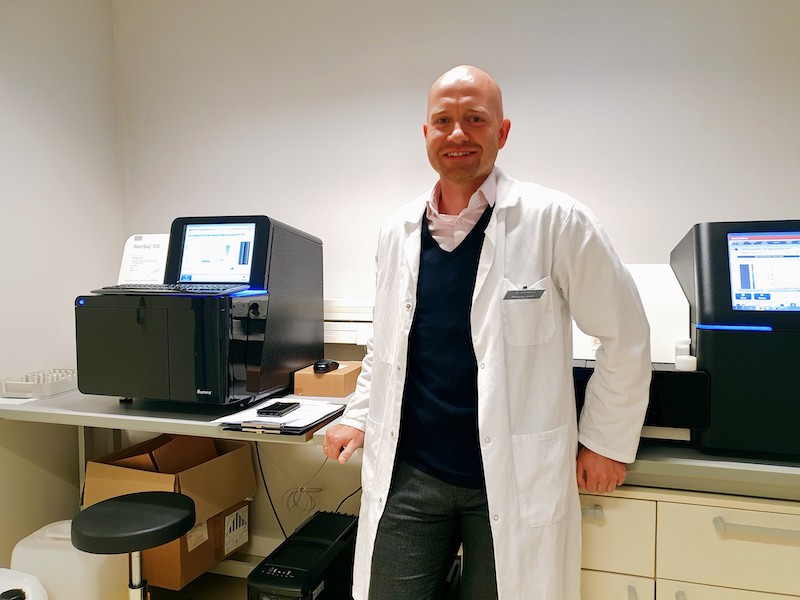- With 425 million cases and 5.9 million deaths reported, the COVID-19 pandemic has had a colossal and devastating impact across the world.
- After numerous lockdowns and seemingly countless restrictions throughout 2020 and 2021, what could the COVID-19 pandemic look like in 2022?
- Here, TechRound explores a range of predictions on what the pandemic could have in store for 2022.
Businesses across a range of industries have been hard hit by the pandemic, with social distancing regulations, work from home orders and closures of non-essential shops creating a tough, unprecedented terrain for entrepreneurs to navigate.
The pandemic has been a challenging time for businesses, revealing the true adaptability and determination of entrepreneurs everywhere with the invention of new, creative, and most importantly COVID-safe, ways to operate in.
As we start to emerge from restrictions, how realistic are our chances for a return to ‘normalcy’ this year? What could COVID-19 have in store for 2022?
We’ve collected predictions from a range of sources, including CEOs, founders, research experts and more to get their thoughts on what COVID-19 will look like in 2022…
Our Panel of Sources:
- Slawomir Kubik – Genomic Research Expert at Sophia Genetics
- Alessio Lorusso – CEO and Founder of Roboze
- Claudia Duran – Director of Endeavor Miami
- Stephen Priestnall – Founder of oomph
- Dr. Matthew Putman – CEO of Nanotronics
- Sam Zietz – CEO of GRUBBRR
For any questions, comments or features, please contact us directly.

Slawomir Kubik, Genomic Research Expert at Sophia Genetics

“It may not be the first time we are looking with hope to go closer to normalcy, but it may be the first time in the past two years that this hope has basis in the data. This holds even if we will not be able to eradicate COVID-19. This holds even if the new infection cases are surging and reaching all-time highs in many countries.”
“The key number is the mortality: it oscillated around 2.5% worldwide a year ago and dropped 10-fold since then. Clearly, global vaccination efforts helped: most fatalities concern the unvaccinated. This should prompt the world leaders to ensure broader access to immunisation. It is not surprising that the most under-immunised (and the least surveilled) continent was the source of Omicron whose subtypes will take over the globe in a few weeks. Fortunately, its genotype, so distant from those encountered before, although allowing to spread at a tremendous rate, makes the disease milder than its predecessors. This may help to build up immunity against the next coming variants by March of 2022 and as much as 80% of the population should develop some level of protection due to either vaccines or past infections.”
“Nevertheless, by no means should we lower our guard. The word “endemic” is recently the most abused and misused word related to COVID-19. We can’t think that not naming the situation “pandemic” will render the virus less dangerous. We will be facing new combinations of mutations and it remains unknown how many of those the virus has down its sleeve. Therefore, the global genomic surveillance should be maintained or extended.”
“There is undoubtedly a need for better, data-based decisions on introducing the restrictions. Omicron was detected before it started to spread but it didn’t stop its dissemination to all continents within a couple of weeks. We need to be better prepared if the next, potentially more dangerous, variant hits. Because it will hit for sure.”
Alessio Lorusso, CEO and Founder of Roboze

“As more people get vaccinated and we learn more about the virus, 2022 should shape into a transition year for returning back to normalcy.”
“However, for many companies like mine, certain practices that emerged during the pandemic will remain in place. Among them, hybrid work for some of our employees will remain an option.”
“Additionally, I do not believe people will be comfortable attending numerous large in-person gatherings throughout the year yet. Especially, while many people are still getting sick with Omicron. Therefore, as a company, we will keep relying on a mixed approach where we will attend a certain number of key events in person while we will keep using alternative virtual forms of communication such as case studies, youtube, and webinars to stay top of mind.”
“Finally, 2022 will still be a year for companies trying to cope with a certain level of uncertainty. New COVID variants may emerge and throw a monkey ranch into a company’s plans, so now more than ever it’s important to have a Plan B and a Plan C ready to be deployed in case Plan A cannot be implemented.”
More from Guides
- Startups in 2025: Why Digital-Readiness Matters from Day One
- How to Use AI to Automate Your Startup’s HR
- How to Use AI to Help You Write a Business Plan
- Internet Sharing and Network Privacy: Should You Use a Proxy Server?
- 10 Tips to Go Viral in the Pet Industry
- Top Alternatives To Shopify
- Crypto Clash: Gate.io Vs. OKX
- 10 Things UK SMEs Should Know About Managed IT Support
Claudia Duran, Director of Endeavor Miami

“I am optimistic that 2022 will bring much needed stability to the world and the global economy. We can perceive the COVID pandemic is changing favourably at a rapid pace with symptoms remaining mild and people starting to slowly go back to the office. As of December 2021, the US Department of Labor has announced an increase in jobs and a decline in the unemployment rate.”
“Last year we saw a great influx of investors and entrepreneurs to Miami from Silicon Valley, New York, and Latin America (LATAM). This has helped the entrepreneurial ecosystem flourish at an unprecedented rate across the state of Florida. Miami is becoming an important TECH HUB and a gateway for LATAM businesses to enter the US market, creating greater opportunities for globalised collaboration and economic development.”
“Now that newcomers have had time to settle down and integrate themselves into the local community, we foresee an even greater level of entrepreneurship and innovation taking root in Miami. An abundance of Tech companies choosing Miami as their base of operations leads us to believe that Fintech, Healthtech, Crypto, and Blockchain industries will perform exceptionally well in the coming months.”
“Two examples of this trend are healthtech company Memic Innovative Surgery and fintech company Securititize. Memic’s Hominis platform is the first and only FDA-authorised surgical robot that features miniature humanoid-shaped arms, with shoulder, elbow, and wrist joints, providing human level dexterity and 360-degree articulation. Securitize is a compliance platform and protocol for issuing and managing digital securities on the blockchain, including dividends, distributions, and share buy-backs.”
“In late 2021, we welcomed these two companies to our global community of high-impact Endeavor Entrepreneurs. We believe our companies are indicators of what is to come. At Endeavor Miami we look forward to continuing to support founders to scale their companies successfully.”
Stephen Priestnall, Founder of oomph

Rethinking our social media use: “Socialisation has never been more important. Isolation imposed by COVID-19 has led to many of us missing social gatherings and face-to-face interactions and as a result, many people are switching off more and more to social media.”
“Social media is moving quickly to a two-tier categorisation – one that promotes connected conversations and another that promotes and is seen to promote conflict amplification.”
“This is being driven by two often competing but gradually converging interests – the interests of wellbeing and the interests of commerce. Increasing awareness of wellbeing issues with over-exposure to negative social media posts and conversations encourage many people, across generational divides, to reduce or exit from particular platform usage. At the same time, brands such as cosmetics company, Lush, is seeing a good reason to move their presence away from the ‘noise’ of broader social media and focus on the likes of YouTube for engagement and Twitter for customer care. It will be interesting to see how brands re-think their social media strategy in 2022.”
The importance of right-place working: “The pandemic is not the reason for organisations to change their expectations of a colleague working place practice, though it is of course an accelerator. The changing nature of work, transformational technology and shifting cultural attitudes to wellbeing are at the heart of this change. Good employers of both contracted and salaried staff are transitioning towards a strategy of ‘right-place working’, considering work needs, colleague cooperation, lifestyle, life-stage and sustainable travel policy. The method and destination of getting to work is no more the sole responsibility of the worker.”
2022 will be the rise in experiences over “things”: “There will be a shift in consumption away from material things and more toward experiences. oomph launched a survey at the start of the pandemic to monitor how people and organisations were reacting to the pandemic. The 3,500 respondents were asked several questions to give insight into the disruption COVID-19 has caused people and it’s evident many have no desire for things to go back to how they once were, the disruption is not going away anytime soon.”
Slowing down is here to stay: “In 2022, people will not rush to fill every day with a commitment of some kind and actually being stuck inside more than ever has made many people realise that we’ve spent too much time rushing, saying yes to so many commitments both professionally and personally, even if the reality of it was we were miserable.”
For any questions, comments or features, please contact us directly.

Dr. Matthew Putman, CEO of Nanotronics

“Due to the COVID-19 pandemic, medical assistance devices are in high demand, resulting in fewer products and higher prices. Supply chain issues – including product scarcity – are likely to continue in 2022,”
“The good news is we have gotten better at fighting the pandemic. There are new med-tech devices that have effectively surpassed the supply chain and can be used for home-care, such as the non-invasive respiratory device we built called nHale. With more resources, more knowledge, and more products to help us in the fight, we will continue to adapt and get better at navigating this virus.”
Sam Zietz, CEO of GRUBBRR

“It is no secret that the labor shortage is the greatest challenge facing restaurant operators right now. To adapt, restaurants have made several operational changes, including limiting hours of operation, reducing dining capacity, increasing menu prices, and removing menu items. However, all of these changes negatively impact the customer experience and are not sustainable in the long run.”
“Self-ordering technology gets to the root of the issue by reducing the need for labor and decreasing operating costs while actually improving the customer experience, providing a win for both consumers and operators. The labor shortage shows no sign of letting up; for restaurant operators that want to not only survive, but thrive in this new labor landscape, the only answer is automation.”
“The value of implementing automation is threefold. Self-ordering kiosks increase revenue through customised upsells and increased average ticket size. In addition, kiosks reduce operating costs by decreasing the dependency on labor (eliminating cashier positions saves on labor costs) and improve the customer experience by minimising or eliminating lines and improving order accuracy.”
“In addition to easing hiring struggles, implementing automation to work alongside employees can help retain your existing restaurant staff, and repurpose them to other essential functions of the restaurant, thus maximising labor. In other words, automation allows you to run your business with fewer high quality employees that can be compensated more.”
“Even something as simple as implementing online ordering or integrations with third party delivery services can significantly boost business. Consumers spend on average 12%-20% more when they order with their eyes and with touch from a self-ordering device than when ordering from a cashier.”
“Fast food restaurants and other establishments that have embraced automation have fared better throughout the pandemic. Restaurants with automation are most poised to stay open because they meet consumers where they’re at– where they want to order.”
For any questions, comments or features, please contact us directly.




